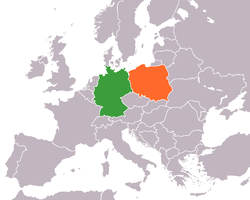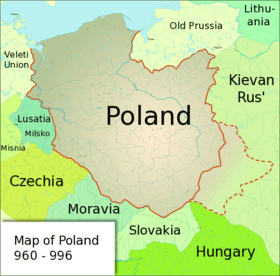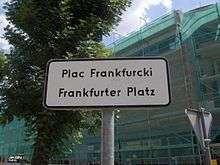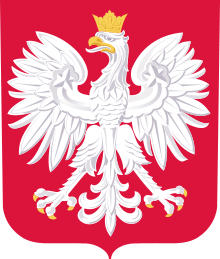Germany–Poland relations
 |
|
Germany |
Poland |
|---|---|
German–Polish relations have a long and complicated history.[1]
From the 10th century on, the Piast Kingdom of Poland established under Duke Mieszko I had close and chequered relations with the Holy Roman Empire. However, these relations were overshadowed by the centuries-long Polish–Teutonic Wars, as a result of which the Teutonic Duchy of Prussia became a fief of the Kingdom of Poland. Prussia retained a certain level of autonomy under Polish rule. Later, the Kingdom of Prussia rose and eventually became one of the partitioners of Poland in 1772–1795.
In 1918, Poland regained its place on the map. After World War I, the Treaty of Versailles deprived Germany of its territories in West Prussia, East Upper Silesia and Danzig and transferred them to Poland. It was seen as a great injustice in the Weimar Republic, in part leading to the Nazi takeover of power in 1933. On 1 September 1939 Poland was invaded by Germany, thus starting World War II. The Third Reich established concentration camps in German occupied Poland, the biggest located in Auschwitz. Poland suffered many casualties and a vast destruction during the war. After World War II, Germany lost its former eastern territories to Poland and the Soviet Union. In 1945-1950, a series of expulsions happened, in which up to 16 million ethnic Germans were forced to leave their homes and resettle in post-war Germany. It was the largest forced movement of any population in history.
The Cold War saw good relations between the communist states of People's Republic of Poland and the German Democratic Republic. Polish-West German relations remained bad, although they improved after Chancellor Willy Brandt launched the Ostpolitik. In 1990, Germany was reunified and it confirmed the Polish-German border on the Oder-Neisse line in a treaty. Both states are now European Union allies and partners.
Overview
A medieval legend about a Polish Princess Wanda shows the German-Polish enmity. In the legend, Princess Wanda rejected to marry Knight Rüdiger, a German ruler. The original chronicle by Wincenty Kadłubek states German troops refused to fight, Rüdiger committed suicide, and Wanda lived a long life. However, later versions say Rüdiger invaded Poland following Wanda's rejection and she drowned herself in the Vistula in order to spare Poland further fighting.[2]
Middle Ages

In the 10th century, the West Slavic Polan tribes under the Piast prince Mieszko I about 960 were able to establish a sovereign state around Poznań and Gniezno in an area later called Greater Poland. Mieszko's territory included Masovia beyond the Vistula river, Silesia and in 962/63 he first met with the Saxon forces of Margrave Gero, ruler of the Marca Geronis between the Saale and Bóbr rivers established in 937 by King Otto I of Germany. During the fight with Germanic duchies Mieszko I in 963 recognized Otto I as Emperor[3] In return for tribute to the newly crowned Emperor, Otto I reckognized Mieszko I as amicus imperatoris ("Friend of the Emperor") and stated that he is dux Poloniae ("Duke of Poland"). As he could not prevail against Gero, Mieszko I resorted to consolidate his realm: he strengthened the relations with the Bohemian duke Boleslaus I by marrying his daughter Dobrawa and converted to Christianity in 966. The next year however, he once again entangled with the troops of the Saxon renegade Wichmann the Younger, fighting over the island of Wolin on the Baltic coast. He also had to defend the Polish border on the lower Oder river against the forces of Margrave Odo I of Lusatia at the 972 Battle of Cedynia.
Meanwhile, Poland had to face the claims to universal power raised by Otto I when he had conquered the Kingdom of Italy and was crowned Holy Roman Emperor by Pope John XII in 962. According to the idea of the translatio imperii, the Emperor would continue the tradition of the Roman and Carolingian Empire as guardian of the Catholic Church superior to all secular and ecclesiastical rulers. Mieszko sought to improve the relations with Otto I: he appeared as amicus imperatoris at the Imperial Diet of Quedlinburg in 973 and in 978 secondly married Oda, the daughter of Dietrich of Haldensleben, margrave of the Northern March. In 984 Mieszko's son Bolesław I Chrobry was married to a daughter of Margrave Rikdag of Meissen. However, in the same year the Polish ruler, instigated by Duke Boleslaus II of Bohemia, interfered in the conflict between minor King Otto III of Germany and the deposed Bavarian duke Henry the Wrangler. He timely switched sides, when he realized that Otto's mother Theophanu would gain the upper hand and in turn sparked a long-term conflict with the Bohemian dukes over Silesia and Lesser Poland. Mieszko backed the German forces several times against the revolting Lutici (Veleti) tribes (though to no avail) and until his death in 992 remained a loyal supporter of the Emperor. Nevertheless, Mieszko precautionally had the Dagome iudex document drawn up, whereby he put his realm called Civitas Schinesghe under the auspices of the Holy See.
Throughout the Middle Ages, the Germans expanded eastwards from modern western and central Germany into the less-populated regions, east of Elbe and Saale rivers. The area of German settlement roughly stretched from Slovenia to Estonia, and southwards into Transylvania. The phenomenon, known as "Ostsiedlung" ("east settlement", "settlement in the east") followed the territorial expansion of the Holy Roman Empire and the Teutonic Order. At various times, Germans were encouraged by Polish Piast rulers to settle in the east. Ethnic conflicts erupted between the newly arrived settlers and local populations.[4] In the 13th century, Poland was suffering from the attacks of Pagan tribes. In response, Konrad I of Masovia hired an army of unemployed crusaders - the Teutonic Order. After the failure of converting the Old Prussians to Christianity, the Order fell into a series of conflicts with the Polish state. As a result, they took the control of the entire southeastern Baltic Sea coast. They remained powerful until 1410, when a combined Lithuanian-Polish army was able to win a decisive victory over the Teutonic Order at Tannenberg.
Modern Age
In the 16th century, after the Counter-Reformation was launched and the Thirty Years War broke out in the German lands, Poland became a Roman Catholic stronghold. In 1683, the Polish army commanded by Polish king John III Sobieski helped to relieve the siege of Vienna and along with the Holy Roman Empire of the German Nation, ended the growing expansion of the Ottoman Empire into Europe.
In the second half of the 18th century, the Polish-Lithuanian Commonwealth was partitioned three times between Russian Empire, Kingdom of Prussia and Habsburg Austria. The partitions took place in 1772, 1793 and 1795. Under Prussian rule in areas where the Polish population lived alongside Germans a virtual apartheid existed, with bans on the Polish language and religious discrimination, besides attempts to colonize the areas with Germans.[5]
Twentieth Century
1918-1939
After Poland regained independence in 1918, it received parts of what had been German territory during the partitions. Much of this territory had been part of Poland in earlier centuries. However, particularly in border regions of Upper Silesia and Greater Poland, Polish and German nationalists fought over the right to the disputed land. Eventually, Poland won back almost all of the province of Greater Poland and the industrialized part of Upper Silesia.
The German-Polish Conferences on School History Books, 1937-8
Two conferences were organised to discuss the school history books being used in Poland and Germany:[6]
The Polish contingent consisted of Professors Dabrowski, Nawroczynski and Kowalski. The German delegates consisted of Aubin, Fitzek and Arnulf Shroder.
Second World War (1939-1945)
In 1939 Nazi Germany invaded Poland and partitioned the country together with the Soviet Union. In 1941 Hitler launched Operation Barbarossa, attacking the Soviet Union.
In 1943 Stalin demanded at the Tehran Conference that the post-war territory of Germany and Poland be redrawn further west as a buffer between Soviet Russia and Germany.
Following the defeat of Germany in 1945, this policy lead to the expulsion of Germans from the territories assigned to Poland.
Cold War (1945 - 1969)
During the Cold War, communist Poland had good relations with East Germany, but during the early Cold War, relations with West Germany were strained.
Ostpolitik (1970 - 1989)
The relations between West Germany and Poland improved through Willy Brandt's Ostpolitk. West Germany recognized the Oder-Neisse line as Poland's western border in the Treaty of Warsaw.
From the fall of Communism to accession (1989 - 2004)
After the fall of communism, Poland and the reunited Germany have had a mostly positive but occasionally strained relationship due to some political issues. After the collapse of the Soviet Union, Germany has been a proponent of Poland's participation in NATO and the European Union. During this time, some reparations from World War II were continued to be repaid to Poland and that money was distributed through the Foundation for Polish-German Reconciliation, a foundation supported by both governments.
The Polish-German border is 467 km long.[7]
Following Accession to the European Union (2004– )
German–Polish are sometimes strained when topics like World War II and the postwar forced expulsion of the German citizens from the territories annexed by Poland are brought up.[8] Occasional xenophobic statements by conservative politicians on both sides, most notably Erika Steinbach[9] and Jarosław Kaczyński, have slowed the improvement of the relations.
On 24 September 2013 Lech Wałęsa suggested the creation of a political union between the Republic of Poland and the Federal Republic of Germany; his reason was that the borders in Europe don't matter anymore and in the future they will change anyway.[10]
Notes and references
- ↑ German-Polish Relations: A History Of Betrayals
- ↑ Vincent Kadlubek legend of Wanda, who lived in the land of the Wandalen, Vandals, page 56,57
- ↑ Reuter, 164. Howorth, 226.
- ↑ The Germans and the East Charles W. Ingrao, Franz A. J. Szabo, Jan Piskorski Medieval Colonization in Europe, page 31, Purdue University Press,2007
- ↑ A history of modern Germany, 1800-2000 Martin Kitchen Wiley-Blackwel 2006, page 130)
- ↑ Germany Turns Eastward by Michael Burleigh, Cambridge University Press, 1988
- ↑ (Polish) Informacje o Polsce - informacje ogólne. Page gives Polish PWN Encyklopedia as reference.
- ↑ Jorunn Sem Fure, Department of History, University of Bergen, "The German-Polish Border Region. A Case of Regional Integration?"
- ↑ http://www.deccanherald.com/content/100437/return-xenophobia.html. Missing or empty
|title=(help); External link in|website=(help); - ↑ Poland and Germany should unite, says Lech Wałęsa, The Daily Telegraph
- German-Polish relations: A History Of Betrayals, Spiegel Online, 18 June 2007
- Timeline: War and Peace in German-Polish Relations, Deutsche Welle, 23 August 2006
- Kimberly Harris, German-Polish Relations, IHJR
- Jean Ciechanowski, German-Polish Relations, International Affairs (Royal Institute of International Affairs 1931-1939), Vol. 12, No. 3 (May 1933), pp. 344–366, JSTOR
- Harold von Riekhoff, German-Polish Relations, 1918-1933, Slavic Review, Vol. 31, No. 4 (Dec., 1972), pp. 917–918
- Reuter, Timothy, The New Cambridge Medieval History, Vol. III: c. 900-c. 1024, Cambridge University Press, 2000


